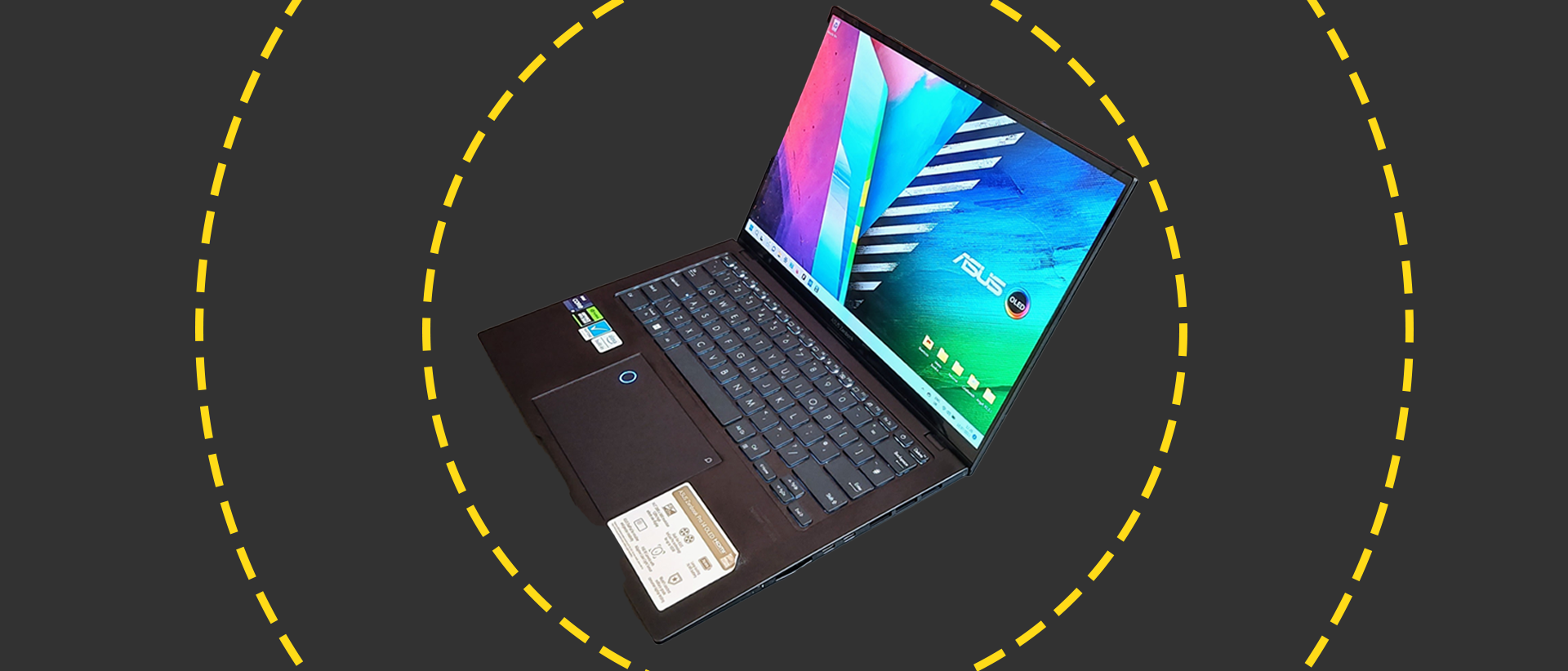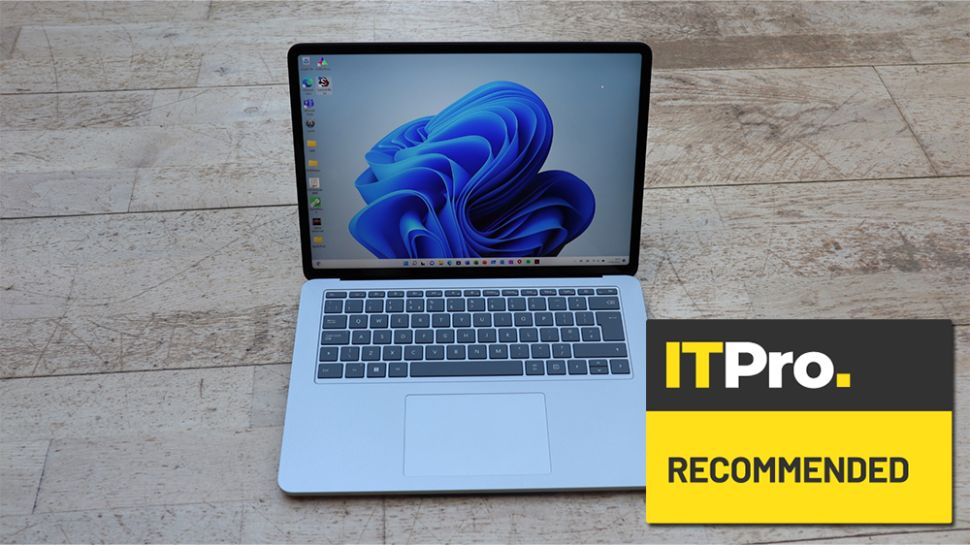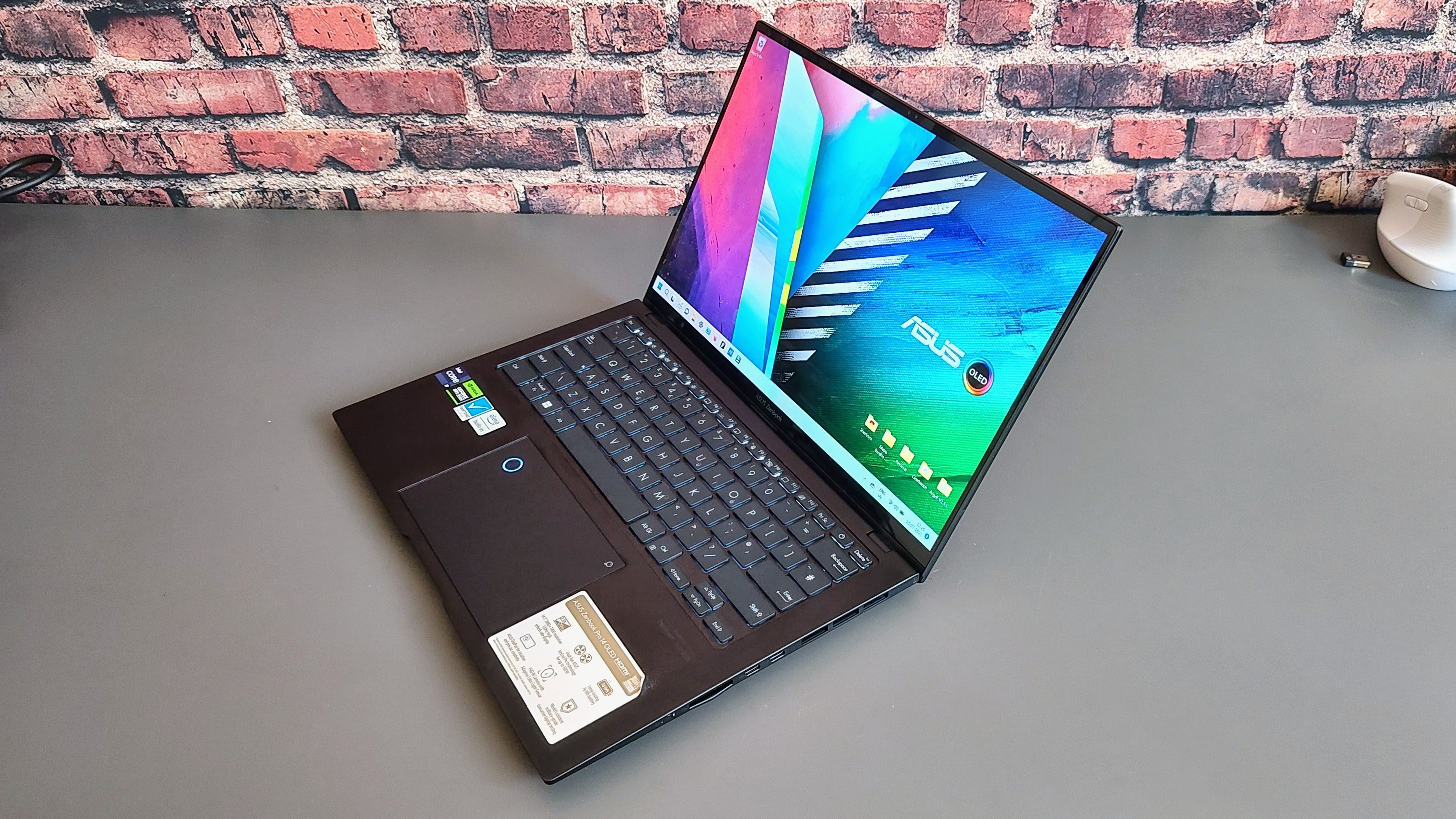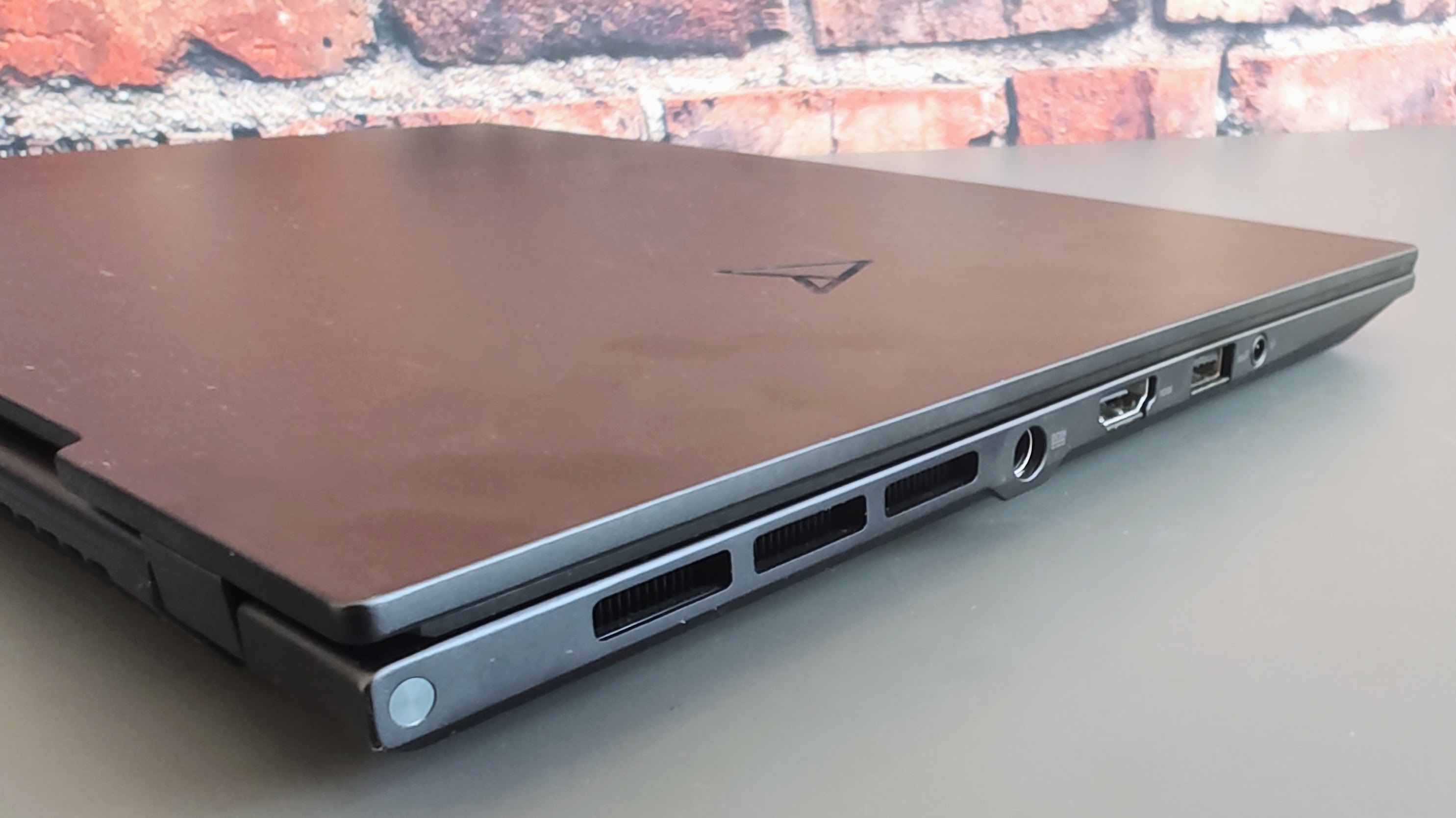Asus Zenbook Pro 14 OLED Review: A strong claimant for the world’s best all-rounder
A mightily powerful 14-in compact with a superb 120Hz OLED touchscreen

-
+
High-performance CPU and GPU
-
+
Superb 120Hz 2.8K OLED touchscreen
-
+
Good selection of I/O ports for a compact
- +
-
-
Battery life mediocre
-
-
No space for a second SSD
-
-
Lifeless touchpad click-action

What we have in the Asus' new Zenbook 14 Pro OLED is a strong claimant for the title of the best all-around compact laptop in the world. With an Intel Core i9 processor, Nvidia GeForce RTX 4070 GPU, 2,880 x 1,800 16:10 OLED touchscreen, and a 2TB SSD, it could be all the laptop anyone needs for portable productivity, creativity, modeling, and even gaming.
Asus is rather cornering the market for high-quality business-grade OLED laptops at the moment, with the Zenbook 14 Flip, Zenbook 14X, and ProArt Studio 16 all receiving plaudits for the quality of their displays on these pages.

Despite the in-house alternatives, the strongest competition for the Zenbook Pro comes not from an OLED laptop but from Apple's MacBook Pro 14, which in 12-core form costs about the same and boasts a superb 14.2-inch Liquid Retina XDR 3,024 x 1,964, albeit non-touch, display.
Asus Zenbook Pro 14: Design
The all-black (the official name is Tech Black) Zenbook Pro 14 is a very angular and industrial piece of design that looks rather dowdy alongside the stylish Zenbook 14X. There's no doubting its solidity; made from aluminum, it's absolutely rock solid. There's no flex to be detected in the lid or the keyboard deck, no matter how brutally you twist or press them.
The smart and functional looks are ruined by the mess of stickers festooned across the keyboard deck's lower part. The Asus sticker on the right feels like it will come away easily; the Intel, Nvidia, Pantone, and Alexa stickers on the left do not.

For a 14.5-inch notebook, the Pro 14 is impressively compact and light; even if at 321.8 x 223.9 x 17.9mm and 1.65Kg it is fractionally larger and heavier than the MacBook Pro. In the Zenbook's favor, it meets the US MIL-STD-810H military-grade standard for resistance to knocks, shocks, and particle ingress.
The Zebook has a good array of I/O ports. On the left, you will find an HDMI 2.1 video output, USB-A 3.2 Gen 2 data port, a 3.5mm audio jack, and a DC-In port for the 200W charger. On the opposite side are two USB-C ports, one Thunderbolt 4 spec, and one USB 3.2 Gen 2 spec, with DP Alt Mode Video output and support for PD charging and an SD card reader.
Sign up today and you will receive a free copy of our Future Focus 2025 report - the leading guidance on AI, cybersecurity and other IT challenges as per 700+ senior executives
Removing the base panel of the Zenbook is easy enough, just as long as you have a Torx screwdriver to hand. Once inside, you can upgrade one of the RAM sticks from 16GB to a maximum of 32GB – the second 16GB module is fixed to the motherboard, as is the Wi-Fi 6E-capable Intel AX211 WLAN card – and swap out the 2TB SSD and the 86Wh battery.
Changing the SSD is arguably pointless as the Micron unit in my test machine returned perfectly solid if unexceptional sequential read and write speeds of 4,621MB/s and 2,623.4MB/s, respectively.
Asus Zenbook Pro 14: Keyboard, Touchpad, and Webcam
The keyboard is rock solid, but the keys only have 1.4mm of travel which is on the shallow side for my taste even if the end-point is well-damped and positive. Overall I'd rate the typing feel as good rather than great.

Given the size of the Zenbook Pro, there's no room for a numeric keypad, but there certainly is for a set of full-sized arrow keys rather than the half-height affairs Asus has opted for. The three-stage white backlight does a good job of keeping things legible in the dark, and it comes with an ambient light sensor to self-adjust.
At 130 x 82mm, the glass-covered touchpad is usefully expansive and very reactive to the touch, but the click-action is both heavy and leaden. You do get used to it, but it's not a positive feature.
Slide your finger in from the top-right corner of the touchpad, and you activate the Asus DialPad, a virtual scroll wheel that sits in the top left corner. You can use this to control system settings like volume or display brightness, but its true value is when it's combined with Adobe Photoshop. Then you can use it to skip between settings and features very quickly.
Some people regard the DialPad as little more than a gimmick which I think is unfair. You do need to dig into it to find the optimal settings and practice with it, but at the very least, in single-function mode, it is a very convenient way to adjust the volume or brightness.
The webcam has a 1080p resolution and can produce a crisp and nicely colored picture, but it lacks the physical shutter that some cheaper Zenbooks feature which could raise privacy concerns in some business environments. The webcam module supports Windows Hello facial recognition, which makes up for the lack of a fingerprint reader and features a selection of image filters and enhancements.
Those enhancements can be accessed via the AiSense submenu in the MyAsus CP and include background blurring, gaze and motion tracking, lighting optimization, and a filter to improve your appearance regarding weight and complexion. You can only have one feature active at a time, and in my case, that was always motion tracking because it does a good job of keeping your face front and center no matter how much you move about.
The noise-canceling microphone array is billed as "AI-driven", but be that as it may, it works well in suppressing background noise, while the Target Speaker Tracking system did an excellent job of targeting individual voices in a group. When it comes to handling multi-user conference calls, the Zenbook Pro 14 really is quite superb.
Asus Zenbook Pro 14: Display
The 14.5-inch 2,880 x 1,800 Samsung-manufactured OLED touchscreen is hard to criticize and should easily satisfy even the most demanding user, even if the MacBook Pro's 14.2-inch Liquid Retina XDR has it beaten in the pixel density stakes by 254dpi to 234dpi. It was beyond the ability of my eyesight to distinguish between the two resolutions.
The Zenbook's display is very colorful, with gamut volumes of 171.6% sRGB, 118.2% Adobe RGB, and 121.6% DCI-P3. Inside the MyAsus app, you will find options to swap between four color profiles; Asus' own Native and sRGB, DCI-P3, and Display P3. When measured against the last two, the Delta E color accuracy came in at 1.6 and 1.1, respectively, which is very good. The display is also Pantone-validated.
When you use the MUX switch to enter discrete GPU mode, you lose the ability to swap between the various color profiles, and the same goes for when you switch to HDR. This has more to do with Windows and Nvidia than Asus, but it's still an area where the supremely well-integrated MacBook steals a march.
Maximum brightness in SDR mode measured 366cd/m2, which jumped to 582cd/m2 in HDR mode from a swatch <10% of the screen area. The contrast ratio is effectively infinite thanks to the absolute blacks that OLED screens can register. The Zenbook Pro 14 carries an official Display HDR True Black 500 rating from Vesa, so HDR content looks superb.
The fully-laminated screen is covered with a layer of Gorilla Glass, giving the panel a gloss finish. I prefer this to a matte effect, both from a visual and tactile stance, but that's very much a personal preference. This is also what makes the lid so stiff.
Motion handling is superb at the risk of stating the obvious about a 120Hz OLED screen with a 0.8ms GtG response time, with no discernible ghosting or smearing. As the Zenbook Pro is not being pitched primarily as a gaming laptop, I cannot mark it down for the absence of support for Nvidia's G-Sync or AMD's FreeSync adaptive synchronization.
Asus Zenbook Pro 14 review: Specs and Performance
The combination of a 14-core Intel Core i9-13900H processor with 32GB of DDR5 RAM and an Nvidia RTX 4070 GPU (using Studio rather than Game Ready drivers) is a combination that makes the Zenbook Pro one of, if not the, most powerful laptops in its class.

In our standard 4K multi-media benchmark, the Zenbook Pro scored 461 points, putting it on par with some seriously powerful gaming laptops and ahead of many workstation notebooks like the MSI Z17.
The Zenbook's RTX 4070 GPU may have a default TGP of just 35W, but the maximum is set to 110W, only 5W shy of the maximum. In the absence of any cooling issues (even when running the punishing FurMark GPU stress test, GPU temperature never exceeded 75°C), the Zenbook makes a good fist of even demanding games.
The Zenbook Pro proved able to run a Triple-A title like Returnal at FullHD with high detail settings and ray-tracing at 65fps with a little help from Nvidia's latest DLSS 3 upscaling and frame generation tech. Metro Exodus, a DLSS 2 title, ran at 60fps, again at FHD with DLSS set to balanced. Those are excellent results from a compact laptop that's not first or foremost a gaming machine.
In a more mundane test, the Zenbook ran the SPECviewperf 3dsmax 3D modeling benchmark at 94fps, which is a solid result for a 1.6 kg compact. The Cinebench R23 multi-core score of 17,859 may not match the likes of the latest super-fast 16-core AMD Dragon Range Ryzen 9 or 24-core Core i9 chips, which can hit over 26,000 and 30,000 respectively, but it's still comfortably in the top decile of mobile CPU results.
All the performance tests were run in Full Speed Mode with both fans running flat out at 7,000rpm. There is some noise to be heard in that mode, but it's less than you'd get from a thoroughbred gaming laptop running hard. A Performance mode between Full Speed and Standard manages fan speed dynamically. There's not much performance difference between the two top settings.
Considering the powerful components buried inside the Zenbook Pro, it didn't do too badly in our battery rundown test, where we run a video in VLC with the display at 170cd/m2. Six hours 40 minutes isn't a result to keep the engineers at Apple awake at night (and make sure you don't leave the MUX switch in discrete GPU mode because that will drop the result to 4 hours 20), but it's a reasonable showing for a machine with an i9 processor and a 76Wh battery.
Asus Zenbook Pro 14 review: Purchasing
The Zenbook Pro comes in two flavors, identical bar the GPU. The RTX 4070 (code UX6404VI) model I tested will set you back £2083.83 ex-VAT. The RTX 4060 model (code UX6404VV) currently only seems to be available in the USA with a price of $1,799 (compared to $2,099 for the RTX 4070 model). That would suggest that if and when the RTX 4060 model comes to the UK, it will cost in the region of £1,900 ex-VAT, which given the pretty marginal difference in non-gaming performance between the RTX 4060 and RTX 4070, makes it the obvious option.
Of course, for that sort of money, you can also get a MacBook Pro 14, which offers better battery run time and a brighter Mini LED display that can handle HDR content more effectively than the Windows-running Asus can. Which you prefer is more a matter of software than hardware, notwithstanding the absence of a touchscreen on the MacBook, with the Zenbook's support for gaming services like Steam likely to tip the balance for many. They are both excellent laptops.
Asus Zenbook Pro 14 specifications
| Display | 14.5-inch 2880 x 1880 OLED touchscreen |
| Processor | Intel Core i9-13900H 12-core 5.4GHz |
| GPU | Nvidia GeForce RTX 4070, 110W max TGP, 8GB vRAM |
| RAM | 32GB LPDDR5 |
| I/O Ports | USB-A 3.2 Gen 1 x 1, USB-A 3.2 Gen 2 x 1, Thunderbolt 4 x 1, SD Card Reader |
| Video Output | HDMI 2.1 x 1, USB-C DP Alt Mode x 2 |
| 3.5mm audio jack | Yes |
| Camera | FHD camera with IR function to support Windows Hello |
| Storage | 2TB M.2 NVMe PCIe 4.0 SSD |
| Wi-Fi | 6GHz Wi-Fi 6E (802.11ax) |
| Bluetooth | v5.2 |
| Weight | 1.65Kg |
| Size | 321.8 x 223.3 x 17.9mm |
| Battery Capacity | 76Wh |
| Operating System | Windows 11 Home |
Over the years, Alun has written freelance for several online publications on subjects ranging from mobile phones to digital audio equipment and PCs and from electric cars to industrial heritage. Before becoming a technology writer, he worked at Sony Music for 15 years. Quite what either occupation has to do with the degree in Early Medieval History he read at the University of Leeds is a bit of a grey area. A native of Scotland but an adopted Mancunian, Alun divides his time between writing, listening to live music, dreaming of the glens and dealing with an unhinged Norwegian Elkhound. For ITPro, Alun reviews laptops and PCs from brands such as Acer, Asus, Lenovo, Dell and HP.
-
 Gender diversity improvements could be the key to tackling the UK's AI skills shortage
Gender diversity improvements could be the key to tackling the UK's AI skills shortageNews Encouraging more women to pursue tech careers could plug huge gaps in the AI workforce
By Ross Kelly Published
-
 Researchers claim Salt Typhoon masterminds learned their trade at Cisco Network Academy
Researchers claim Salt Typhoon masterminds learned their trade at Cisco Network AcademyNews The Salt Typhoon hacker group has targeted telecoms operators and US National Guard networks in recent years
By Emma Woollacott Published
-
 HPE says unified channel strategy won't force Juniper partners to generalize
HPE says unified channel strategy won't force Juniper partners to generalizeNews Does the company embrace specialists or want a full portfolio push? The answer, it seems, is both
By Jane McCallion Published
